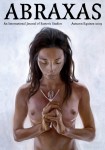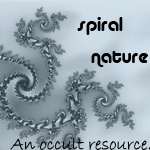Review of Abraxas, no. I
By Psyche | January 13, 2010 | Print This Post | E-mail This Post | 3 Comments
Ok, so I received this copy of  Abraxas back in September during my visit to Treadwell’s. This review has been a long time in coming. What took so long?
Abraxas back in September during my visit to Treadwell’s. This review has been a long time in coming. What took so long?
Mostly, I wanted to do it properly. I didn’t want to rush reading bits and pieces here and there, I wanted to really sit down and savour it.
Abraxas isn’t just “An International Journal of Esoteric Studies”, this first issue is also an art book. At 290mm x 232mm it’s a large quarto, beautifully bound, and printed on high quality paper, including a handtipped sheet. Richly coloured paintings are beautifully reproduced, along with many lovely illustrations in monochrome. And then there’s the text.
This first issue focuses largely on witchcraft, and while I can’t detail every essay that appears, I would like to highlight several that I felt stood out in this already exceptional collection.
Stephen Grasso’s piece “Skip Witches, Hop Toads”, illuminates the difference between magickians and witches in a way that is raw and present.
Witchcraft is an old animism felt in the heart. It is non-verbal and cannot be described in language without its substance getting lost in translation. It can only be alluded to and suggested. The lens of science will never observe an undine or dryad, but these terms are a convenient and poetic way of describing a very real congress that takes place between human consciousness and the manifest mysteries of nature, when you approach the latter in the mode of a witch.1
It almost makes me wish I were a witch. (Almost.)
An essay on flying ointments by Sarah Penicka-Smith, “Caveat Anonyter!”, discusses their origin and possible components using various historical sources. She also remarks on their rejection by practitioners of modern witchcraft and Druidry, along with other (unspecified) “illegal drugs” in favour of trance states achieved by other, often unspecified means.
Phil Hine’s informative and sympathetic account of the many (fabricated) adventures of Tuesday Lobsang Rampa and his more earthly counterpart Cyril Henry Hoskin is a fascinating read in “The Third Eye”. An alleged Tibetan Buddhist, Hoskin turned out to be an Englishman who’d never left the country of his birth. Many readers were genuinely inspired by his works, despite their dubious veracity and this is what Hine would have use take from his stories. It seems the best possible outcome.
Also included are the paintings and lithographs of Francesco Parisi are lovely, and his interview with Robert Ansell discuss Parisi’s influences, including Austin Osman Spare. As well as a previously unpublished poem by Aleister Crowley, “BABALON”.
It is expensive, yes, but gorgeous and decadent and worth it. As stated on Fulgur’s website:
We might not be hand-numbering these, but then, we won’t be reprinting them either. There are less than you think…
If this is the future of occult journals, then it is in very capable hands. Pick it up while you can.
Footnotes:
- Stephen Grasso in Abraxas, “Skip Witches, Hop Toads”, p. 32 [back]
Save & Share: Del.icio.us Digg Facebook Stumble it! Tweet





[...] This post was mentioned on Twitter by Nico Psyche and Frater_Puck, Jon Boy Waldorf. Jon Boy Waldorf said: RT @plutopsyche: PL: Review of Abraxas, no. I http://bit.ly/7hGJq9 [...]
I have been anticipating the release of Abraxas since earlier last summer and I have to say it has exceeded my expectations. The articles and artwork are top notch. Definitely worth the price, so if anyone reading this hasn’t ordered a copy yet I strongly recommend you do so before they are all gone.
[...] Stephen Grasso’s piece “Skip Witches, Hop Toads”, illuminates the difference between magickians and witches in a way that is raw and present. Witchcraft is an old animism felt in the heart. It is non-verbal and cannot be described in language without its substance getting lost in translation. It can only be alluded to and suggested. The lens of science will never observe an undine or dryad, but these terms are a convenient and poetic way of describing a very real congress that takes place between human consciousness and the manifest mysteries of nature, when you approach the latter in the mode of a witch.1 [...]